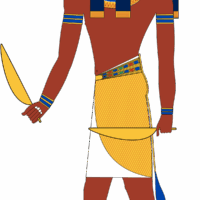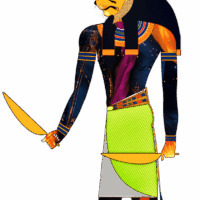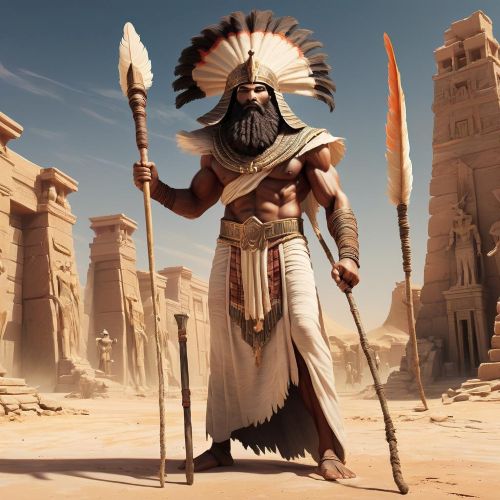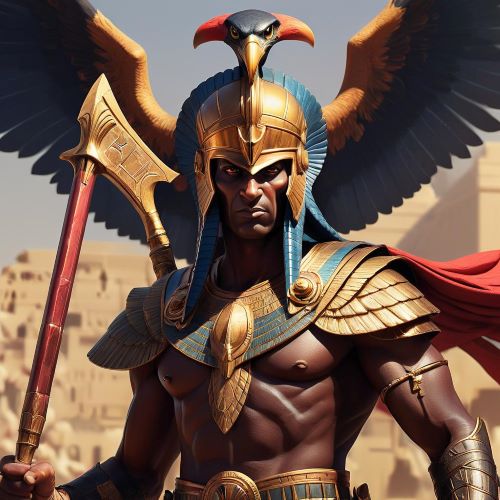Maahes : God of War
Listen
At a glance
| Description | |
|---|---|
| Origin | Egyptian Mythology |
| Classification | Gods |
| Family Members | Ptah (Father), Sekhmet (Mother) |
| Region | Egypt |
| Associated With | War, Protection |
Maahes
Introduction
Maahes, the lion-headed god of ancient Egypt, embodied a raw, untamed divine force that stood for justice, protection, and war. Though not as widely known today as Ra or Osiris, Maahes held an important place in Egyptian theology, particularly during the New Kingdom. His identity merged traits of nobility and wrath, often linked to both his feline appearance and his role as a guardian of order. Some scholars believe his origins may trace to foreign lion-gods like Apedemak, highlighting Egypt’s long-standing cultural exchanges with Nubia. His worship was centered in cities like Leontopolis and Bubastis, where lions were not only sacred but literally kept in temple precincts, reflecting his living presence among the people.
Physical Traits
Visually striking, Maahes is portrayed with the head of a mature male lion atop a man’s body—an image meant to inspire both awe and reverence. His regal form is often adorned with the solar disk and uraeus, affirming his solar associations and divine authority. While one hand might grasp a blade as a tool of divine judgment, the other may hold a lotus bouquet—an emblem of healing and rebirth that connects him with Nefertem. His depictions sometimes vary depending on region, but a common thread remains: his powerful frame, sharp eyes, and symbolic weaponry broadcast his roles as both protector and punisher.
Family
The lineage of Maahes is multifaceted, hinting at his wide-reaching influence in Egyptian mythology. Most traditions consider him the son of Ptah, the craftsman god, and either Bastet or Sekhmet—goddesses who personify feline duality. Bastet represents nurturing protection, while Sekhmet exudes destructive firepower. This dual heritage explains Maahes’ ability to both defend and destroy. His close ties to Nefertem, another divine child of Ptah, often blur the lines between brother, twin, or complementary deity. In some accounts, he is even linked to Ra, further intensifying his solar symbolism and reinforcing his identity as a fiery force of divine will.
Other names
Throughout ancient texts and across cultures, Maahes was known by various names and titles. The Greeks adapted his name into forms like Miysis, Mios, and Mihos, often comparing him to their own avenging spirits. His Egyptian epithets captured his ferocity and righteousness: “Lord of Slaughter,” “Wielder of the Knife,” and “The Scarlet Lord” evoke the battlefield, while “Avenger of Wrongs” and “Protector of Sacred Places” highlight his noble mission. Each title paints a different aspect of his divine persona, combining aggression, vigilance, and virtue. These names weren’t just ornamental—they served to define how priests, kings, and citizens interacted with his divine power.
Powers and Abilities
Maahes was a god of terrifying might and unwavering justice. As a war deity, he fought not just human foes, but also cosmic threats, joining Ra in nightly battles against Apep, the serpent of chaos. In times of crisis, Egyptians believed Maahes could annihilate enemies with supernatural precision. His link to weather—especially storms—further underscored his unpredictable yet potent nature. He didn’t just fight evil; he embodied divine vengeance. As a solar warrior, his heat mirrored the desert’s fury, while his connection to sacred order (Ma’at) made him a cosmic enforcer. Even his association with lions in temples wasn’t symbolic alone—these animals, under his name, patrolled holy sites as living guardians.
Modern Day Influence
Although Maahes is no longer actively worshipped, his symbolic presence lingers in modern culture and scholarly pursuits. In Egypt, lion imagery remains prominent in public monuments, notably the lion statues of Qasr El Nil Bridge in Cairo—silent yet enduring testaments to the power and majesty he once represented. In the realm of fiction and pop culture, Maahes has appeared in graphic novels, games, and speculative fiction as an archetype of righteous vengeance or divine warrior. Modern spiritual practices, particularly among neopagans and Kemetic revivalists, often invoke his image for protection, courage, or justice. Additionally, ongoing archaeological research into his temples and artifacts offers fresh insights into the lesser-known layers of ancient Egyptian religious life, bringing Maahes back into focus as more than just a side figure in myth—rather, as a vital symbol of power rooted in balance.
Related Images
Source
Wikipedia. (2002, October 1). Maahes – Wikipedia. Retrieved from https://en.wikipedia.org/wiki/Maahes
Wilkinson, R. H. (2003). The Complete Gods and Goddesses of Ancient Egypt. Thames & Hudson.
worldhistoryedu.com. (n.d.). Maahes: the Ancient Egyptian Lion-Headed God of War. Retrieved from https://www.worldhistoryedu.com/maahes-the-ancient-egyptian-lion-headed-god-of-war/
Bard, K. A. (2008). An Introduction to the Archaeology of Ancient Egypt. Wiley-Blackwell.
Pinch, G. (2002). Handbook of Egyptian Mythology. ABC-CLIO.
Sesh Kemet Egyptian Scribe. (n.d.). Mai-hesa/ Ma’ahes – 𓏞𓀀 Sesh Kemet Egyptian Scribe 𓆎𓅓𓏏𓊖. Retrieved from https://seshkemet.weebly.com/mai-hesa-maahes.html
Shadow Stalkers Wiki – Fandom. (n.d.). Maahes | Shadow Stalkers Wiki – Fandom. Retrieved from https://shadowstalkers.fandom.com/wiki/Maahes
The Enlightenment Journey. (n.d.). Maahes: Lion God of War and Protection – The Enlightenment Journey. Retrieved from https://www.enlightenmentjourney.com/maahes-lion-god-of-war-and-protection/
Frequently Asked Questions
What is lorem Ipsum?
I am text block. Click edit button to change this text. Lorem ipsum dolor sit amet, consectetur adipiscing elit. Ut elit tellus, luctus nec ullamcorper mattis, pulvinar dapibus leo.
What is lorem Ipsum?
I am text block. Click edit button to change this text. Lorem ipsum dolor sit amet, consectetur adipiscing elit. Ut elit tellus, luctus nec ullamcorper mattis, pulvinar dapibus leo.
What is lorem Ipsum?
I am text block. Click edit button to change this text. Lorem ipsum dolor sit amet, consectetur adipiscing elit. Ut elit tellus, luctus nec ullamcorper mattis, pulvinar dapibus leo.
What is lorem Ipsum?
I am text block. Click edit button to change this text. Lorem ipsum dolor sit amet, consectetur adipiscing elit. Ut elit tellus, luctus nec ullamcorper mattis, pulvinar dapibus leo.
What is lorem Ipsum?
I am text block. Click edit button to change this text. Lorem ipsum dolor sit amet, consectetur adipiscing elit. Ut elit tellus, luctus nec ullamcorper mattis, pulvinar dapibus leo.














